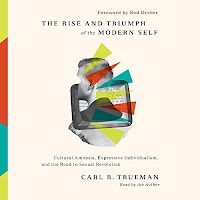Chapter 10 of Carl Trueman's book, "The Triumph of the T," does an excellent job of situating the programmatic basis of the unity of the LGBTQ+ movement. Trueman demonstrates familiarity with the academic and mid-level popular texts that have framed the movements for legal and social recognition of the legitimacy of gays and lesbians.
Originally rooted in the sexed differences of male and female coupled with same-sex attraction, male and female homosexuals had little in common. Drawing on the work of Adrienne Rich (and later Germaine Greer), Trueman observes that "[male] homosexuality and lesbianism are not simply the male and female versions of a single broader phenomenon (erotic attraction to the same sex). [They] are actually two different phenomena because of how they stand in relation to the broader power structures of society ..." (342) Traditional social organization often privileges males. Thus, "lumping together lesbians and male homosexuals in a common category is an act of male domination."
If Trueman is correct, that when lesbians and gays come together politically, "bodily differences must be sideline or attenuated," (343) then what accounts for a united movement for legal and social acceptance? In short, "their shared victimhood as marginalized sexual minorities." (345) "Virtuous victimhood is a powerful catalyst for political coalitions in the modern world" (350) that for several centuries has identified the sovereign, psychological self as the "nature" of human nature. "Reality is inward and psychological, not outward and natural," and this is true of "all twenty-first century Westerners ..." (340). We have met the enemy, and he [sic] is us.
The transgendered movement compounds the elision of gendered sex seen first in the political unity of gays and lesbians. Sexed human nature may have been downplayed by gays and lesbians in the interests of political expediency but it was not denied. Transgendered individuals, however, deny any "biologically shaped approach in favor of a much more psychological and free-floating notion of gender." (353) Even so, the political virtue of victimhood permitted the addition of T to LGBTQ+.
Demands for legal recognition is one thing. The social demands of transgendered females is another: "resentment of transgender people, particularly men claiming to be women, [is] rife within the lesbian community," (354) or so Trueman reports. Why would feminists and lesbians feel resentment against their transgendered fellows? Drawing on the work of Janice Raymond, it is because
Transgenderism essentially depoliticizes the matter of being a woman. Being a woman is now something that can be produced by a technique ... The pain, the struggle, and the history of oppression that shape what it means to be a woman in society are thus trivialized and rendered irrelevant. (360)
Trueman then turns to Germain Greer who similarly argues that "sex-change surgery simply removes the most distinctive elements of male sexual anatomy; it does not add the critical components of womb and ovary." (361) Why are these components of female anatomy important? Because they "provide the experiences that constitute womanhood: menstruation and pregnancy." To ignore these essential [sic] features of biological femaleness is "to engage in a self-deception."
By making common cause first with gays and then with the transgendered, feminists generally and lesbians particularly have written their own epitaph. It is unlikely that, as The Economist recently suggested, future Olympics will divide competitors into two groups, open and female. Transgendered females will come ever more to dominate sport and, one wonders, the boardroom, at the expense of those born XX. Women, those blessed with the biology associated with XX chromosomes, will find themselves more marginalized as the decades wear on. The current TERF wars (here and here) are only a harbinger of things to come.





No comments:
Post a Comment